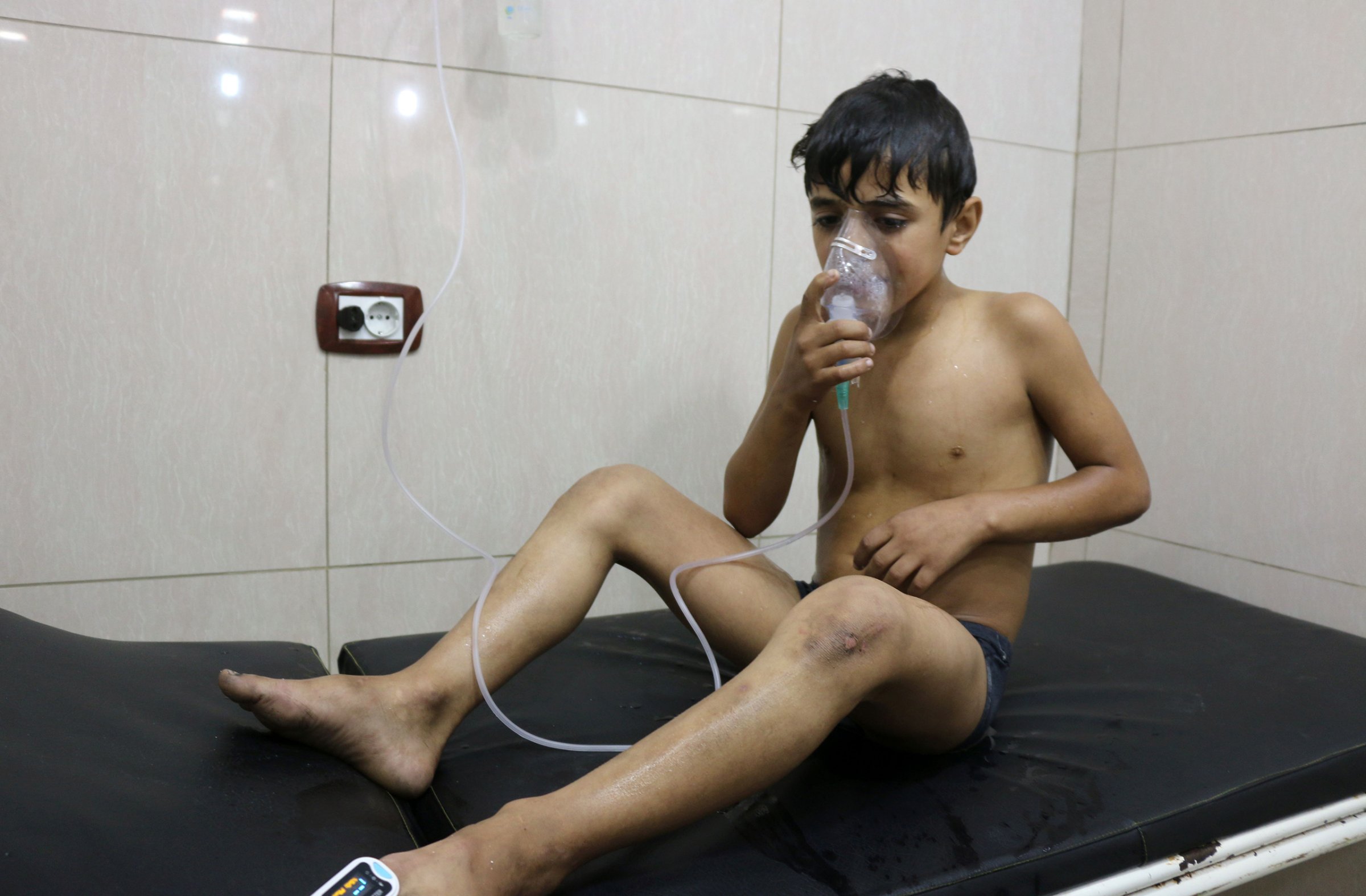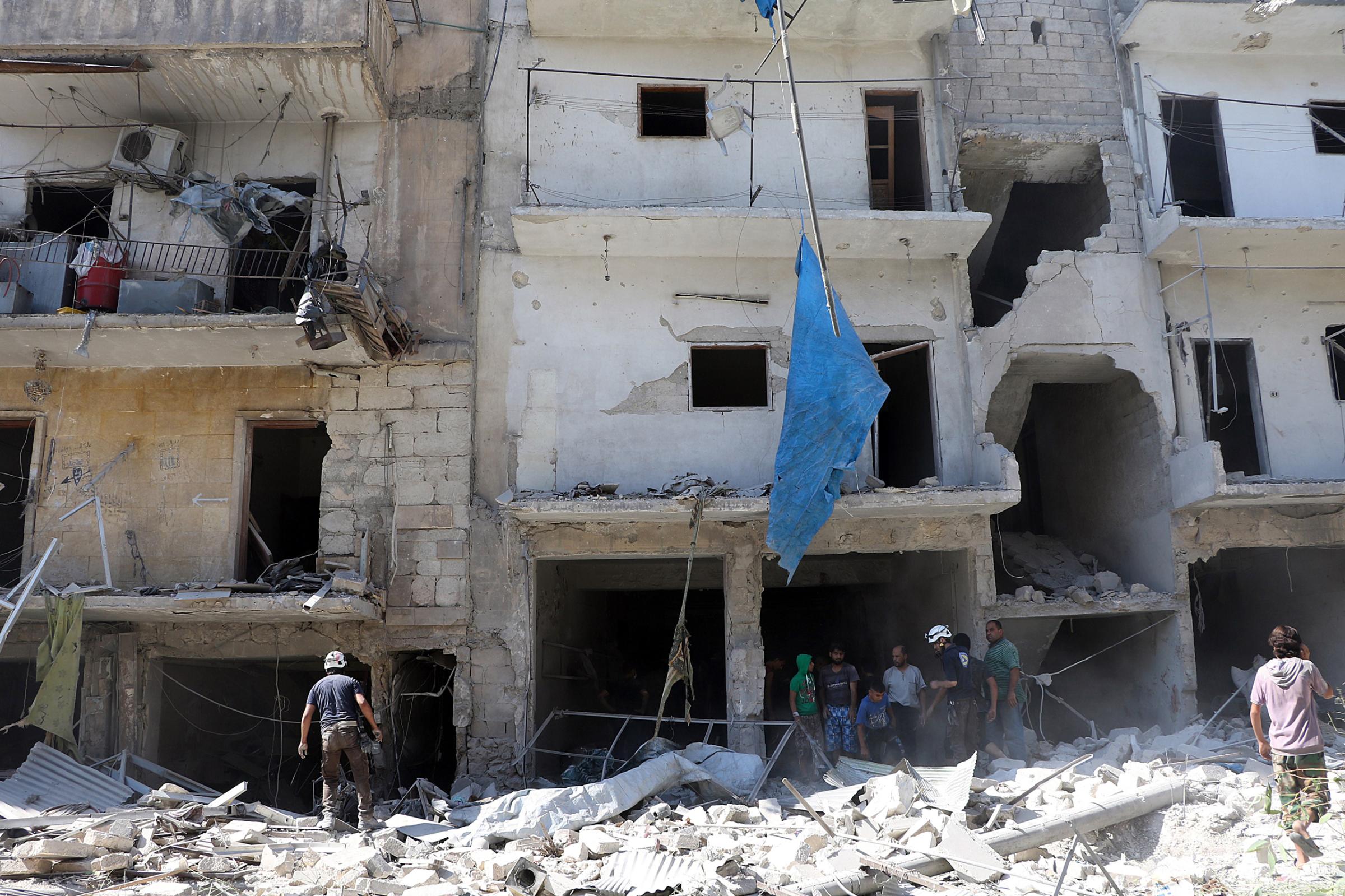
The bomb fell at around midday. Dropped from a helicopter, the barrel burst open and spawned its contents onto the pavement: at least four metal cylinders that ripped open to release a greenish gas that smelled of bleach. Within minutes, residents began to hack on the fumes.
Rescue workers raced to the scene of the Sept. 6 strike, a crowded neighborhood in Aleppo’s Sukari district in the rebel-held eastern section of the city. The rescuers tended to dazed residents, some of whom were coughing violently, struggling to breathe. They helped a young boy strip off his clothes and hosed him down while rushing others to hospitals. The barrel bomb had left a small crater in a narrow street between apartment buildings. The canisters lay nearby. Later, one witness said he saw two dead chickens lying in the street, expired from the gas. At Aleppo’s al-Quds hospital, doctors scrambled to scrub patients’ bodies and administer oxygen to some of the more than 70 coughing, shaking patients.
Hamza al-Khatib, a surgeon at the hospital, said he immediately identified the airstrike as a chemical attack, based on the symptoms (coughing, a lack of oxygen, itching skin) and the smell on the patients’ clothes. He was shocked to see five and six year old children holding their own oxygen masks to their faces “without help, like they were grown men, understanding that it is their way to relieve their suffering.”
Ahmed Mustafa, a 28-year-old media activist and journalist with the channel Halab al-Youm (Aleppo Today), arrived in Sukari minutes after the bomb fell to document the attack. Later that day he was treated for the effects of the gas. “My feeling was a sense of fear, sadness, death,” he says in a text message. Witnesses, doctors on the scene, and international experts suspect the gas used in last week’s attack was chlorine, an easily manufactured substance that the regime uses as a low-tech but still lethal chemical weapon.
The attack on the urban area of Aleppo was the latest in a pattern of chemical attacks in Syria carried out by President Bashar al-Assad’s regime in territory held by armed opposition groups in the weeks and months before the partial ceasefire negotiated by the U.S. and Russia, which went into effect on Sept. 12.

Activists say these attacks could represent a worrying shift in regime tactics. In the past, chemical attacks have been seen as part of a deliberate effort by the regime to displace civilians from rebel-held areas. But now with the deployment of toxic gasses on the besieged eastern part of Aleppo, the attacks are targeting a captive population.
“It’s the first time this year Aleppo city was targeted by chemical agents. We had many reports before but we were unable to confirm it—of using choking agents—but the recent two attacks were completely confirmed,” says Dr. Houssam Alnahhas, coordinator of the Chemical, Biological, Radiological, and Nuclear Taskforce of the independent Union of Medical Care and Relief Organizations operating in Syria, speaking from neighboring Turkey.
At least two people died as a result of the attack last Tuesday, including a 13-year-old girl named Hajer Kyali, who died a day later after being admitted to an intensive care unit. Last Tuesday’s bombing was at least the second toxic assault on the rebel-held section of Aleppo in the last two months. On Aug. 10, an apparent chlorine bombing struck Aleppo’s Zibdieh neighborhood, killing a woman and two children. Both attacks came before the current truce.
Even in the charnel house of the Syrian civil war, chemical attacks represent a special brand of horror for civilian victims. Chlorine can be deadly. As victims inhale, it reacts with the lungs, turning into hydrochloric acid. “It dissolves the lungs as you breathe it in, and that’s how kids usually die,” says Dr. Annie Sparrow, assistant professor at the Icahn School of Medicine at Mount Sinai Hospital in New York, who has worked closely with doctors in Syria.
Physicians and human rights advocates argue the chlorine attacks are designed to sow terror, rather than cause mass casualties. Unlike ordinary bombs, or the makeshift barrel bombs used by the Assad regime, there is no sheltering underground from toxic gasses. In fact, experts say chlorine gas sinks after its released, potentially seeping into subterranean chambers.
The use of chlorine as a weapon of war dates back to World War One, when the German military unleashed green clouds of the gas on French Algerian troops at the second Battle of Ypres, reportedly killing thousands. The world’s horror at the Germans’ use of chlorine gas spurred international efforts to outlaw the use of chemical weapons in general. Chlorine is a legal industrial chemical, but its use as a weapon is now banned under the 1993 Chemical Weapons Convention, which is the most universally accepted of the world’s disarmament treaties.
“It’s a terrifying weapon,” says Ole Solvang, deputy director of the emergencies department at Human Rights Watch, speaking from Paris. “It creates a lot of terror among the civilian population because unlike high a explosive weapon—it explodes and you know whether you’re injured or not—is it over? And you can go on with your life. With these chlorine-filled barrel bombs, it impacts, and then you don’t know, where did it happen? Will you be affected?”
The attacks have continued long after an organized international mission removed the Syrian regime’s known chemical arsenal from the country in June 2014. The removal was the result of the dramatic diplomacy that followed the August 2013 sarin gas attack in the rebel-held Ghouta area outside of Damascus in August 2013, in which as many as 1,400 people were killed. President Barack Obama threatened military action in Syria in response, having declared the use of chemical weapons a “red line” in August 2012. The Obama administration backed away from the brink of launching an attack on Syria after the Ghouta killings, after reaching a last minute agreement with Russia to dismantle the Syrian chemical arsenal.
Instead of halting chemical warfare in Syria, the 2013 international accord appears to have simply triggered a shift in the type of chemicals used. The international operation removed 1,290 metric tons of chemical weapons such as sarin, VX, and sulfur mustard, which forms mustard gas, all of which are banned under international law. The operation did not remove any stocks of chlorine, which can be used in everything from purifying drinking water to whitening laundry. As a result, the Syrian regime appears to have adopted a makeshift approach to chemical warfare, packing chlorine canisters into barrel bombs, crude metal containers that are pushed out of helicopters, often into civilian neighborhoods.
The attacks are widespread, many of them targeting rebel-held northwestern Syria. According to a report from the Syrian American Medical Society, 161 documented chemical attacks took place in Syria from the beginning of the conflict through 2015, the vast majority of them involving suspected chlorine gas. The report also says 77 percent of the attacks came after the U.N. Security Council resolution in 2013 that led to the destruction of Syria’s declared chemical weapons stockpiles. Most of the attacks were carried out by the Assad regime, but the jihadists of ISIS have also been known to use chemical weapons, according to the report.
In the most recent pair of attacks in Aleppo, it was impossible for officials to carry out laboratory tests to confirm which chemical agent was used, since the area was under siege and no samples could be taken out of the city. But there is little doubt in investigators’ minds that the gas was chlorine. Medics reported symptoms consistent with past chlorine attacks: itching, coughing, and respiratory symptoms such as a lack of oxygen. The Health Directorate issued a medical report confirming “chlorine toxicity” following the Sept. 6 attack.
Official investigations have confirmed the use of chlorine in previous attacks. An investigative mission set up by the U.N. and the International Organization for the Prohibition of Chemical Weapons confirmed several attacks in a report to the UN Security Council in August.
Some experts say the regime may be experimenting with industrial chemicals in an attempt to sow fear among the public in opposition-controlled areas. “They’ve kind of got a whole population where they can use any number of chemicals they’ve got in their warehouses,” says Sparrow, in a phone interview. “Sometimes you think they’re just doing it for effect. Maybe they’re seeing if this one works. Maybe they’re doing it to terrify people because they know that anything that smells odorous and maliferous will be terrifying, because it will be.”
Rights activists believe the unchecked use of chemical weapons in Syria could embolden combatants in wars around the world. “If this continues without any kind of reaction, without any kind of consequences, then that sends a signal to actors in other wars as well, that this international norm on chemical weapons is not as strong as we thought it was,” says Solvang.
A senior Obama administration official said the current ceasefire agreement negotiated with Russia should represent a “significant step” toward preventing the Assad regime’s indiscriminate bombing. “We will continue our efforts to hold the Assad regime to account for their actions, including the specific individuals who authorized and carried out these chemical attacks,” said the official.
With reporting by Massimo Calabresi / Washington.
More Must-Reads from TIME
- Why Trump’s Message Worked on Latino Men
- What Trump’s Win Could Mean for Housing
- The 100 Must-Read Books of 2024
- Sleep Doctors Share the 1 Tip That’s Changed Their Lives
- Column: Let’s Bring Back Romance
- What It’s Like to Have Long COVID As a Kid
- FX’s Say Nothing Is the Must-Watch Political Thriller of 2024
- Merle Bombardieri Is Helping People Make the Baby Decision
Contact us at letters@time.com